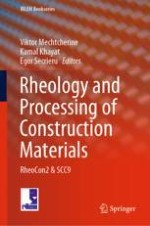2020 | OriginalPaper | Chapter
Challenges in Rheological Characterization of Cement Pastes Using a Parallel-Plates Geometry
Authors : Aida Margarita Ley-Hernández, Dimitri Feys
Published in: Rheology and Processing of Construction Materials
Publisher: Springer International Publishing
Activate our intelligent search to find suitable subject content or patents.
Select sections of text to find matching patents with Artificial Intelligence. powered by
Select sections of text to find additional relevant content using AI-assisted search. powered by
